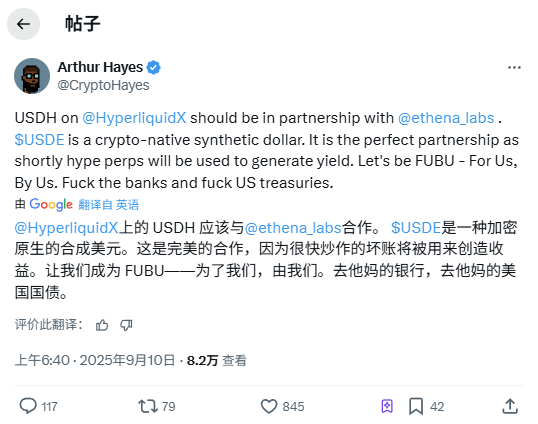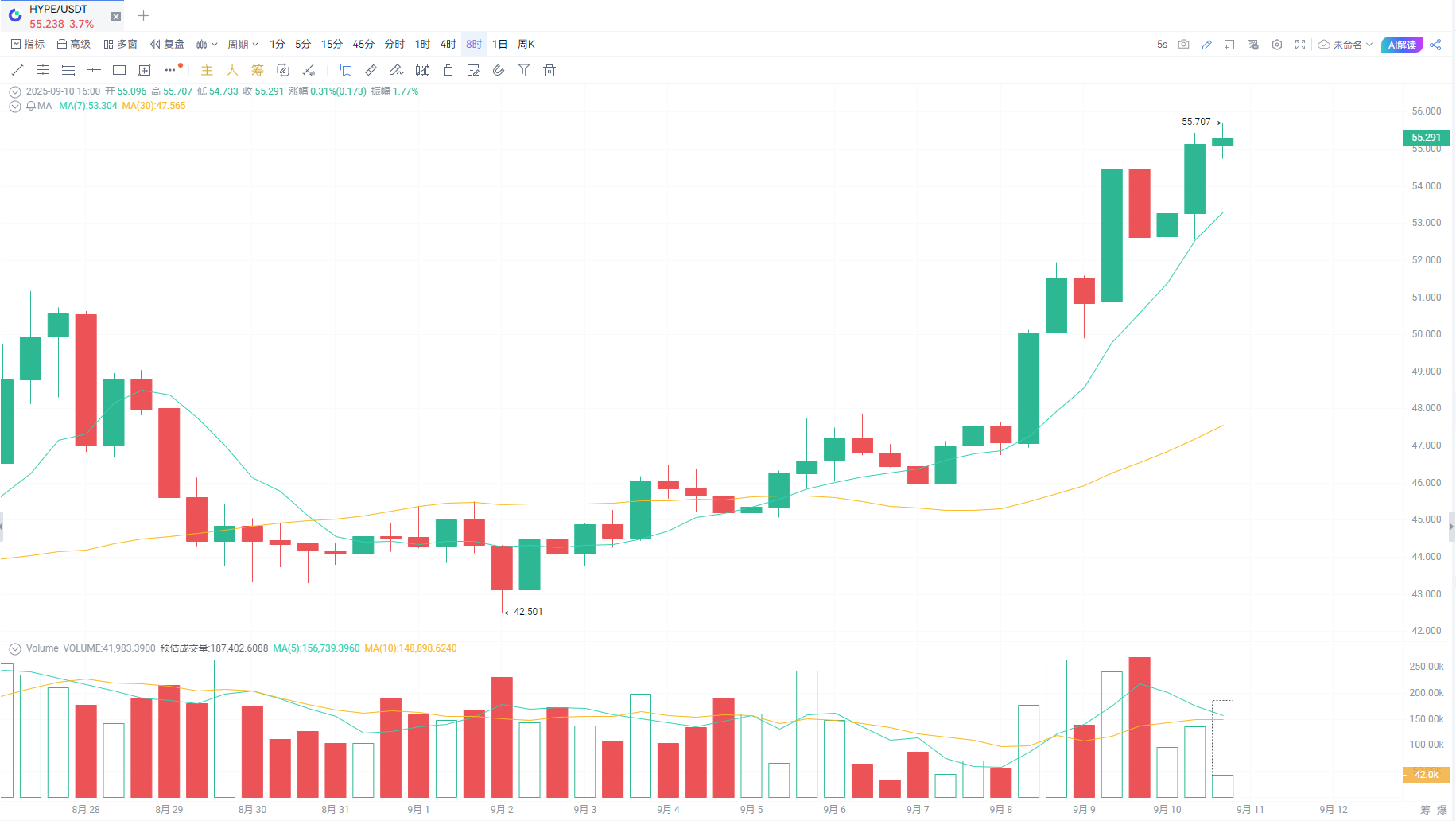In September, BitMEX co-founder Arthur Hayes spoke out again, pointing out that the upcoming stablecoin USDH from Hyperliquid should collaborate deeply with Ethena Labs. “The USDH on @HyperliquidX should work with @ethena_labs. $USDE is a crypto-native synthetic dollar. This is a perfect collaboration, as soon the bad debts from speculation will be used to generate returns.” Hayes' comments stirred up a wave of discussion in the market regarding DeFi stablecoins and highlighted the strategic shift in the Hyperliquid ecosystem.

As a decentralized perpetual contract exchange, Hyperliquid has become a dark horse in the DeFi space for 2025. Its HYPE token surged to a historical high of $55 in the past two days, thanks to optimism from institutions like VanEck and the platform's monthly trading volume exceeding $400 billion. However, Hyperliquid's core pain point lies in its reliance on USDC as the primary quoted asset, which not only increases dependence on Circle but also limits the ecosystem's autonomy. To address this, the platform recently launched a bidding process for the USDH stablecoin, inviting multiple protocols to propose their solutions, aiming to create a native, compliant dollar-pegged asset. Bidders include giants like Ethena Labs, Sky, Paxos, Frax, and Agora, with voting set to begin on September 14. This process is not merely a technical tender but a test of the future governance and yield distribution in DeFi.

As a seasoned macro analyst in the crypto space, Hayes has long been optimistic about the "yield revolution" in DeFi. In an interview with Bitcoin.com News on September 9, Hayes emphasized that weak U.S. economic data would drive the Federal Reserve to cut interest rates by 50 basis points, and the decline in 2-year U.S. Treasury yields would release trillions of dollars from money market funds (MMFs) into high-yield DeFi products. He specifically mentioned Ethena's sUSDe token, which offers a 7% annualized yield far exceeding traditional government bonds, attracting institutional capital. Hayes predicts that the supply of USDe will surpass $20 billion, targeting the market shares of USDC and USDT. In this macro context, Hayes views Hyperliquid as the "future model" of DeFi: a platform that does not require VC control over profits and directly shares them with users. He believes that if USDH combines with USDe, it will utilize Hyperliquid's HYPE perpetual contracts as a hedging tool to achieve a closed-loop yield generation for synthetic dollars. This is not just a technical integration but a declaration against the hegemony of traditional finance.
On September 9, Ethena officially submitted its USDH issuance proposal, promising that it would be 100% collateralized by its USDtb, a compliant stablecoin developed in collaboration with Anchorage Digital Bank (an OCC-chartered crypto bank) and BlackRock's BUIDL fund. USDtb has achieved $23 billion in minting and redemption without any security incidents or downtime records, and its smart contracts have been audited with no medium to high-risk vulnerabilities, complying with the upcoming GENIUS Act. Ethena emphasized that USDH will be safeguarded by a network of validators elected by Hyperliquid (including LayerZero, among others), independently handling security incidents to ensure decentralized governance.
The core appeal of the proposal lies in yield distribution: 95% of the net income from USDH reserves will be returned to the Hyperliquid community for HYPE token buybacks, aid funds, or staking rewards. Additionally, Ethena has committed to a $75 million (expandable to $150 million) incentive fund to support the HIP-3 market (Hyperliquid's expanded perpetual contract mechanism) and front-end integration for builders. At the same time, they will cover all transaction costs for migrating from USDC to USDH, facilitating a smooth transition for core trading pairs. Ethena also launched hUSDe—a Hyperliquid-specific branch of USDe, exposed only to the platform market, with long positions acquiring through Unit spot assets. This will make USDH, USDe, and hUSDe the largest fee sources for HIP-3, further amplifying Hyperliquid's liquidity.
The strategic depth of this proposal goes beyond merely issuing a stablecoin. Ethena plans to collaborate with Securitize to deploy tokenized real-world assets (such as stocks and funds) to HyperEVM (Hyperliquid's EVM-compatible chain) at no cost, with native USDtb support provided through Anchorage. Performance metrics are equally stringent: the USDH supply target is $5 billion, with peg stability maintained at $1 ± 20 basis points for 99.5% uptime. In the future, the community can vote to adjust collateral diversification to avoid single reliance. Ethena's community contributions are already showing signs: they are collaborating with BasedOneX to build the HyENA trading tool and deploying hUSDe to enhance liquidity. Hayes' endorsement further amplifies its influence; he recently increased his holdings in ENA (Ethena token) to $3.48 million and predicts a short-term surge to $1.50.
Sky, as the fifth-largest bidder, has committed to a $25 million investment and will utilize LayerZero to support multi-chain deployment. Paxos, Frax, and Agora emphasize full collateralization and complete yield sharing but lack the scale proof and partner network of Ethena. Hyperliquid's "outsourcing" strategy has been hailed as a genius move: by opening up bidding, the platform not only avoids the legal and technical pitfalls of stablecoin construction but also forces giants to relinquish 95%-100% of protocol profits for the HYPE ecosystem. Camila Russo commented on X: “Hyperliquid's outsourcing of USDH is a genius move; competition has driven massive concessions while diversifying USDC reliance.”
Stablecoins have evolved from mere anchoring tools to weapons of dollarization, and Hayes candidly stated in the interview: “Stablecoins are weapons of dollarization.” The potential marriage between Hyperliquid and Ethena will embed HYPE perpetual contracts into USDe yield generation, challenging the monopoly of banks and government bonds. The 7% yield of sUSDe will attract MMF funds like a magnet during the interest rate cut cycle, allowing DeFi to share in the spoils. If the proposal passes, with USDH supply reaching $5 billion, Hyperliquid's point value could return to the $800 high. However, risks remain: regulatory uncertainties, peg stability, and BTC/ETH pullbacks affecting ENA/HYPE.
In summary, Hayes' support is not a fleeting whim but a bet on the future of DeFi autonomy. The vote on September 14 will determine whether Hyperliquid steps into a new era of "for us, by us."
This article is for informational sharing only and does not constitute any investment advice for anyone.
Join our community to discuss this event
Official Telegram community: t.me/aicoincn
Chat room: Wealth Group
免责声明:本文章仅代表作者个人观点,不代表本平台的立场和观点。本文章仅供信息分享,不构成对任何人的任何投资建议。用户与作者之间的任何争议,与本平台无关。如网页中刊载的文章或图片涉及侵权,请提供相关的权利证明和身份证明发送邮件到support@aicoin.com,本平台相关工作人员将会进行核查。




